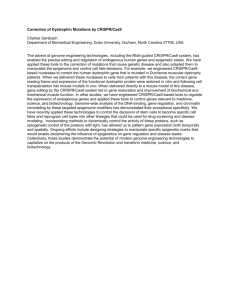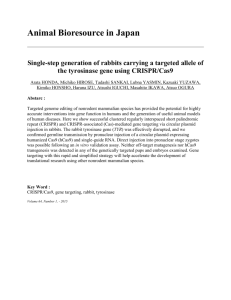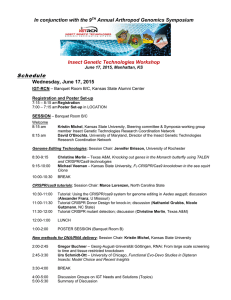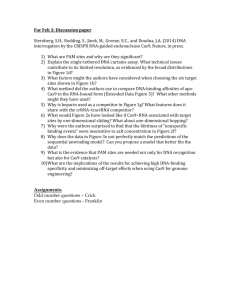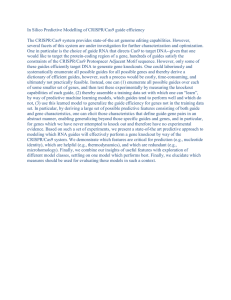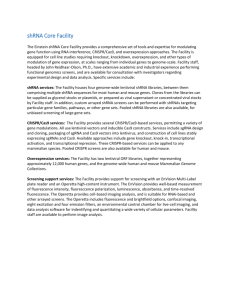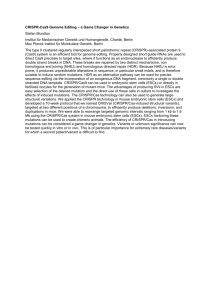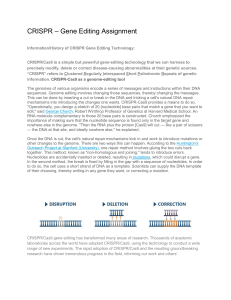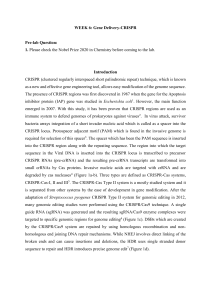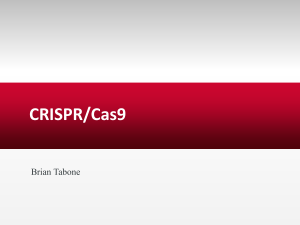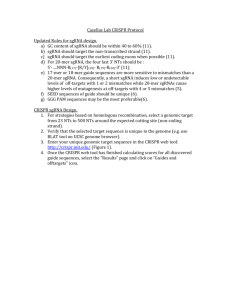Intro_to_CRISPR
advertisement
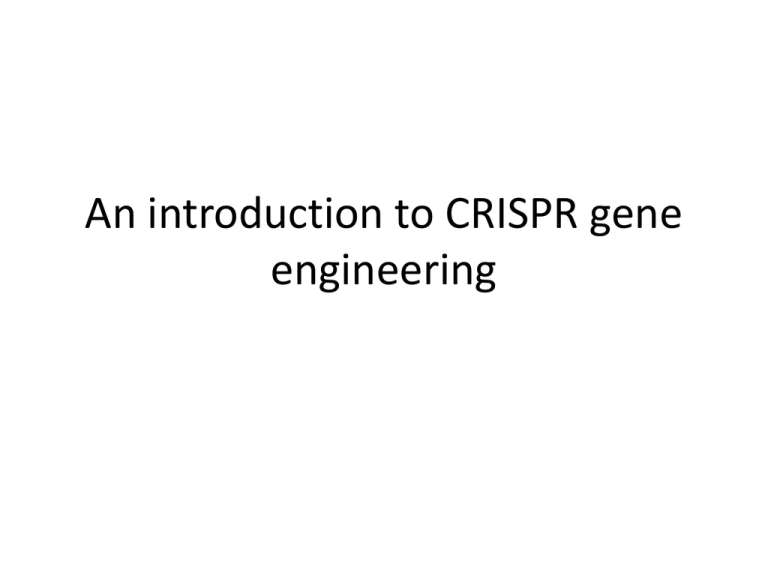
An introduction to CRISPR gene engineering Introduction to CRISPR http://www.addgene.org/CRISPR/guide/ Wiedenheft et al. Nature 2012 • 3 distinct types of bacterial CRISPR systems identified so far: – Type I, II, III – Type II is the basis for current genome engineering applications • From Streptococcus pyogenes • The S. pyogenes system is orthogonal to the native E. coli system Jinek et al., Science 2012 • Genomic manipulation requires only : – the Cas9 protein and – an engineered small guide RNA (sgRNA) with a PAM sequence upstream of target complementary sequence • Contains a designed hairpin to mimic the CRISPR RNA and trans-acting RNA complex • Base-pairing between the sgRNA and target DNA causes double-strand breaks due to the endonuclease activity of Cas9 http://www.addgene.org/CRISPR/guide/ Qi et al. Cell 2013 • DNA target does not need to be unique and can appear in multiple locations, all of which will be targeted by the Cas9 nuclease for cleavage – can be on a plasmid or integrated into the bacterial genome. • The sgRNA can bind on either strand of DNA and the Cas9 will cleave both strands (double strand break, DSB). The DSB results in the silencing of that DNA sequence. • Changing the target specificity of the RNA-protein complex does not require protein engineering but only the design of the short crRNA guide • Directing the specificity of dual-RNA:Cas9 with several different crRNAs allows for the introduction of multiple mutations at the same time. Jiang et al. Nature Biotech, 2013 CRISPRi (CRISPR interference) • Repurposed for genome regulation rather than gene editing • Catalytically inactive version of Cas9 (no endonucleolytic activity) – Modified transcription without genetic alteration of the target gene sequence • sgRNA comprises 3 segments: – 20-nt sequence complementary to target – 42-nt Cas9-binding hairpin (Cas9 handle) – 40-nt transcription terminator Larson et al., Nature protocols 2013 Qi et al., Cell 2013 Location of target sequence matters CRISPRi functions by blocking transcription through physical obstruction of RNA polymerase *Different from RNAi-based silencing, which requires the destruction of already transcribed mRNA Repression effect is inducible and reversible An aTc-inducible promoter was used in this case. High specificity and can simultaneously regulate multiple genes Specificity is determined by the PAM region (2bp) and at least a 12bp sgRNA stretch (from 5’end) Repression efficiency can be enhanced by combining nonoverlapping sgRNAs targeted against the same gene Imaging genomic loci in living human cells Chen et al. Cell 2013 • Can be used to: – Efficiently and selectively repress transcription of target genes – Target large numbers of genes to infer gene function, or map genetic interactions through gene pairs – Probe regulatory functions (activating / repressing / neutral) of genes and cis elements in a complex regulatory network – Manipulate microbial genomes, esp. nonmodel organisms with limited genetic tools developed – Image genomic loci in living cells • Limitations: – The requirement for the NGG PAM sequence for Cas9 limits the availability of target sites • • Though other Cas9 homologs may use different PAM sequences S. pyogenes Cas9 could partially recognize an NAG PAM sequence – Some target sequences may be problematic due to the RNA secondary structure that may form Larson et al., Nature protocols 2013 Can measure effects on transcription using qRT-PCR or genome-wide NET-seq. Can also check for effects on protein expression if the target gene was fused to a fluorescent protein / lacZ Larson et al., Nature protocols 2013 Designing / making plasmids • http://www.addgene.org/crispr/marraffini/ • http://www.addgene.org/crispr/church/ Inferring players in a signal tranduction network Qi et al., Cell 2013 References • • • • • • • • RNA-guided genetic silencing systems in bacteria and archaea. Blake Wiedenheft, Samuel H. Sternberg & Jennifer A. Doudna. Nature 2012 Multiplex Genome Engineering Using CRISPR/Cas Systems. Le Cong et al. Science 2013. Orthogonal Cas9 proteins for RNA-guided gene regulation and editing. Esvelt et al. Nature Methods 2013 A Programmable Dual-RNA–Guided DNA Endonuclease in Adaptive Bacterial Immunity. Jinek et al. Science 2012 RNA-guided editing of bacterial genomes using CRISPR-Cas systems. Jiang et al. Nature Biotech 2013 Dynamic Imaging of Genomic Loci in Living Human Cells by an Optimized CRISPR/Cas System. Chen et al. Cell 2013 CRISPR interference (CRISPRi) for sequence-specific control of gene expression. Larson et al., Nature protocols 2013 Repurposing CRISPR as an RNA-Guided Platform for Sequence-Specific Control of Gene Expression. Qi et al., Cell 2013
